Watford, Hertfordshire
Up to 1834
According to the 1725 edition of An Account of Several Workhouses..., parish workhouses already existed at Abbotts Langley, Aldenham, and Watford.
A parliamentary report of 1777 recorded parish workhouses in operation at Watford (for up to 100 inmates), Abbotts [Langley] (44), Aldenham (30), and Rickmersworth [Rickmansworth] (80).
Aldenham's workhouse was built in around 1782 to the north of the parish church. The long building was divided into a men's half and a women's half. After the formation of the Watford Poor Law Union in 1835, it was sold off to the Stuart family of Aldenham Abbey (later Wall hall) and was converted into an inn known as the Red Lion. The venture proved unsuccessful and the building was converted into dwellings known as Red Lion Cottages which still stand today.
Rickmansworth workhouse stood at the north side of the High Street, immediately to the east of the Baptist church, where Centurion House now stands.
After 1834
Watford Poor Law Union was formed on 23rd May, 1835. Its operation was overseen by an elected Board of Guardians, 16 in number, representing its 6 constituent parishes as listed below (figures in brackets indicate numbers of Guardians if more than one):
County of Hertford: Abbot's Langley (2), Aldenham (2), Bushey (2), Rickmansworth (4), Sarratt, Watford (5).
The population falling within the union at the 1831 census had been 15,379 with parishes ranging in size from Sarratt (population 452) to Watford itself (5,293). The average annual poor-rate expenditure for the period 1832-35 had been £8,473 or 11s.0d. per head of the population.
Initially, the union made use of existing parish workhouse premises. At first, all able-bodied paupers were sent to Abbotts Langley, the young and infirm to Rickmansworth and the paupers in Bushey to Aldenham. Subsequently, able-bodied women and children were placed in Watford workhouse and aged married persons were sent to Rickmansworth together.
A new Watford Union workhouse was built in 1836-7 on the south side of Hagden Lane (now Vicarage Road) in Watford. It was designed by TL Evans who was also the architect of the Bishop's Stortford and Westbury & Whorwellsdown workhouses. The location and layout of his Watford design are shown on the 1913 OS map below.
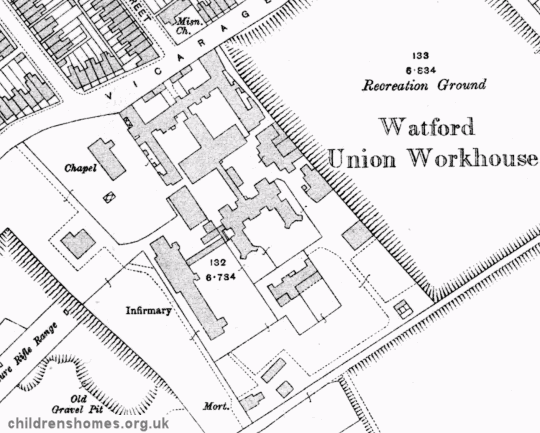
Watford workhouse site, 1913.
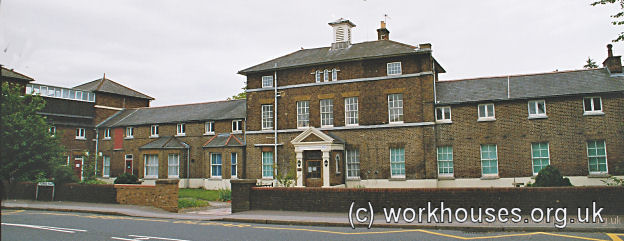
Watford entrance block from the north-east, 2004.
© Peter Higginbotham.
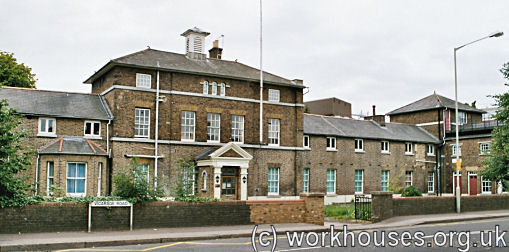
Watford entrance block from the north, 2004.
© Peter Higginbotham.
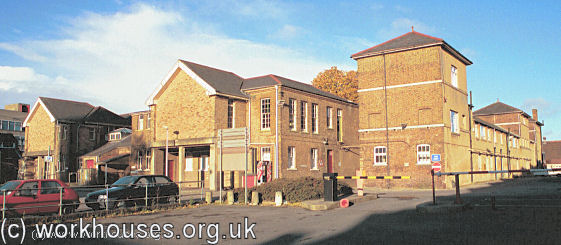
Watford general view from the south-east, 2000.
© Peter Higginbotham.
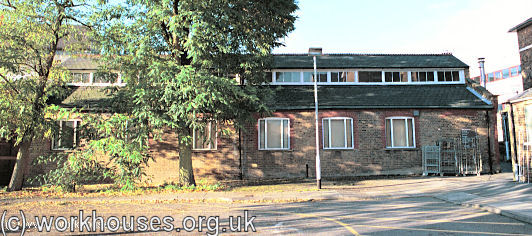
Watford workshop block from the east, 2000.
© Peter Higginbotham.
From 1904, to protect them from disadvantage in later life, the birth certificates for those born in the workhouse gave its address just as 60 Vicarage Road, Watford.
A new infirmary, at the south-west of the workhouse, was opened on 25 January 1908. The building, providing a total of 109 beds, contained two long wards (one male, one female), each 92 feet by 24 feet and holding 30 beds. There were also separate wards for cancer, erysipelas (an infectious skin condition), 'offensive cases, and children. There was also a lock (venereal) ward, and various spaces and wards for special cases. There were two duty rooms, four bathrooms, and two day-rooms for convalescent patients. The whole building was lit by electricity, and hanging between each bed were lamps which could be switched on when a doctor or nurse had to attend a patient at night. There were two iron staircases at each end of the building for fire escapes. The scheme also included a separate block for phthisis (tuberculosis of the lungs) cases. It was separated from the infirmary by a recreation ground intended for the use of convalescent phthisis patients. The phthisis block had two wards, one with eight beds for males, the other with four beds for females. The beds were on india rubber wheels so that they could be easily moved out on to the verandah, allowing for open-air treatment. The new and old infirmaries were linked by a covered and electrically-list walkway. A new laundry was also erected.
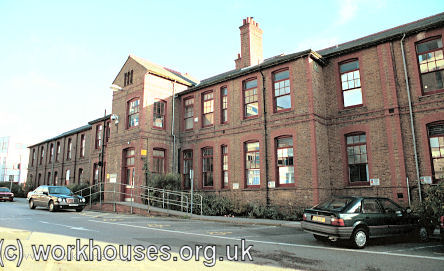
Watford 1908 infirmary block from the south, 2000.
© Peter Higginbotham.
After 1929, the workhouse changed its name to Shrodells Public Assistance Institution. After the introduction of the National Health Service in 1948 it became Watford General Hospital.
Children's Homes
In the early 1900s, Watford set up at least two scattered homes. One of these was large house at Ashby Road, Callow Land, Watford, which in 1908 could house 15 boys and 15 girls. By 1929, an extension to the building had increased its capacity to 65. The property is now in private residential use.
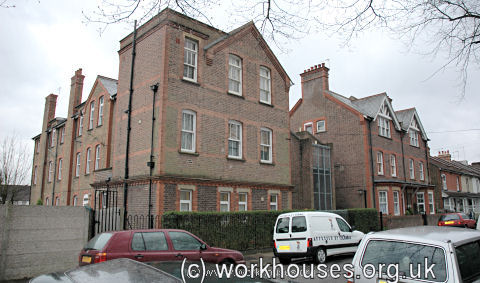
Former children's home, Ashby Road, Watford, 2005.
© Peter Higginbotham.
By 1915, another home was in operation in a property known as Stamford House on Park Road, Watford. The building no longer exists.
Staff
Inmates
Records
Note: many repositories impose a closure period of up to 100 years for records identifying individuals. Before travelling a long distance, always check that the records you want to consult will be available.
- Hertfordshire Archives and Local Studies, County Hall, Pegs Lane, Hertford SG13 8DE. Limited holdings include: Guardians' minutes (1835-1913); Register of children (1903-38).
- Watford Museum, 194 High Street, Watford, Hertfordshire WD17 2DT. Holdings: Register of births in the workhouse (1866-1933); Register of deaths (1948-58); Punishment book (1914-43).
Bibliography
- Gutchen RM, Truwert E, and Peters G (1984) Down and Out in Hertfordshire — A Symposium on the Old and New Poor Law (Hertfordshire Publications)
- An Account of Several Work-houses for Employing and Maintaining the Poor. Anon, 1725.
Links
- None.
Unless otherwise indicated, this page () is copyright Peter Higginbotham. Contents may not be reproduced without permission.


